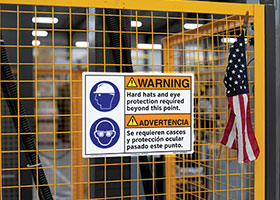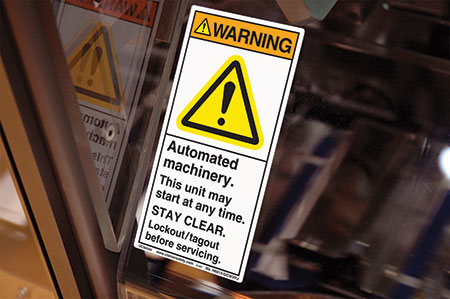Integrating Safety Labels and Signs Into Employee Training
Posted by Geoffrey Peckham | 9th Dec 2015

The goal for every company should be to have a safety culture – one that upholds the value of human life and strives to continually improve conditions, processes and environments that will keep workers safe. To help make such a culture possible, safety training needs to occur to inform and remind workers of safety-related issues. And this is where your facility’s safety signs and the safety labels that appear on your equipment are tools your company can use to reinforce your objective to make safety the number one priority.
If you think about it, most safety training occurs in a “lesson” format. An issue is raised, safety ramifications are discussed and the safe work behavior is decided upon. Videos, presentations, lectures, reading material and the like are often used. But what’s lacking is the continued visual reminder at the point of interaction with the potential hazard – and that’s where safety signs and labels play an invaluable role. Well-designed signs and labels can serve this function. By “well-designed” I mean signs and labels that use the latest formats and symbols and that are designed as a “system” to effectively communicate safety. Such signs and labels are the permanent reminders of your company’s safety training and established safe work practices.

One interesting point on this topic is that a lot of the equipment in use in facilities today was made thirty years ago or more. This equipment’s safety labels are not up to today’s best practices when it comes to warnings. Yet it’s generally not up to the owner of the equipment to update its labeling. Nor is it the original manufacturer’s job, since, presumably, its labels were in compliance with the latest standards when the equipment was manufactured and sold decades ago. In our experience, we have found that the best way to handle this is for the owner of the equipment to request new labels from the original manufacturer (assuming they’re still in business). And to make sure the original equipment manufacturer understands that you want warnings that are up-to-date with current standards. Consider putting them in touch with Clarion to make sure the warning labels you receive will be compliant with best practices.
When people’s lives and your company’s safety record are on the line, making sure the safety signs and labels in use in your facility are the best they can be is a perfect objective.
Geoffrey Peckham
CEO, Clarion Safety Systems

This blog is part of a series of regular posts from our CEO, Geoffrey Peckham, to share his insight. Geoffrey serves as chair of the ANSI Z535 Committee for Safety Signs and Colors and chair of the U.S. TAG to ISO/TC 145 – Graphical Symbols. He has also been selected as a member of the U.S. TAG to ISO/PC 283, an ISO committee writing a new standard, ISO 45001 Occupational Health and Safety Management Systems, which will, when finished, define global best practices for workplace safety. In addition, he is an active member of many industry-specific standards committees related to safety signs and labels for buildings, ships, machinery and products.